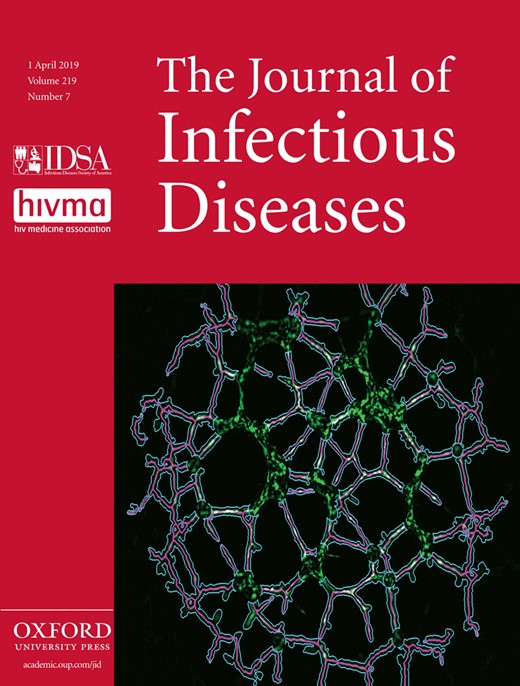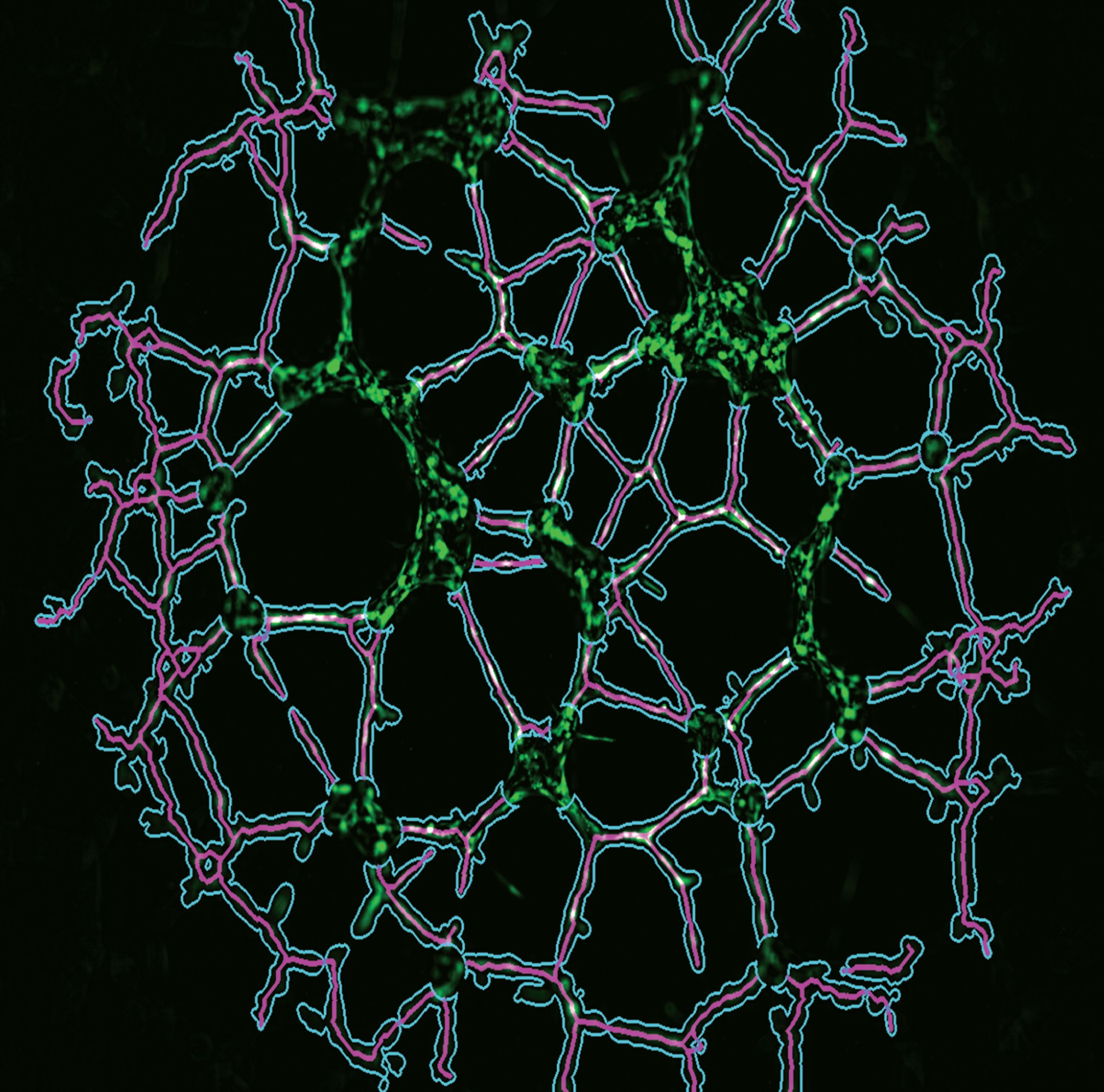
Cover image

Volume 219, Issue 7, 1 April 2019
EDITORIAL COMMENTARY
Inhibiting Viral Polymerase and Neuraminidase in Treating Influenza
REVIEW ARTICLE
Therapeutic Use of the Human Papillomavirus Vaccine on Recurrent Respiratory Papillomatosis: A Systematic Review and Meta-Analysis
This updated and thorough review and meta-analyses supports the continued use of the human papillomavirus vaccine as an adjuvant treatment of recurrent respiratory papillomatosis, because significantly fewer surgical procedures per month are required after vaccination.
MAJOR ARTICLES AND BRIEF REPORTS
VIRUSES
Phase 2b Study of Pimodivir (JNJ-63623872) as Monotherapy or in Combination With Oseltamivir for Treatment of Acute Uncomplicated Seasonal Influenza A: TOPAZ Trial
Pimodivir is a first-in-class inhibitor of the influenza virus polymerase basic protein 2. This dose-ranging study was designed to evaluate the efficacy and safety of pimodivir in patients with naturally acquired influenza A virus infection and to evaluate the optimal dose for further development.
Highly Sensitive and Specific Zika Virus Serological Assays Using a Magnetic Modulation Biosensing System
Current serological assays that detect antiviral antibodies suffer from low sensitivity and high cross-reactivity. Utilizing a novel Magnetic Modulation Biosensing system and the Zika non-structural 1 protein, we achieved 88–97% sensitivity, much higher than the current state-of-the-art ELISA.
High Environmental Stability of Hepatitis B Virus and Inactivation Requirements for Chemical Biocides
An Intensive, Active Surveillance Reveals Continuous Invasion and High Diversity of Rhinovirus in Households
Through an intensive, active surveillance of human rhinovirus (HRV) in households, we observed continuous invasion and high diversity of HRV. Individual repeat infections were frequent, decreasing with age, and almost invariably heterotypic, indicative of lasting type-specific immunity and low cross-type protection.
Viral Genetics Modulate Orolabial Herpes Simplex Virus Type 1 Shedding in Humans
Oral herpes simplex virus type 1 (HSV-1) shedding rates, host cellular responses, and genotyped viral strains were characterized in monozygotic and dizygotic twins to determine whether the HSV-1 infection severity is influenced by host or viral genotype. Viral strain characteristics contribute to oral HSV-1 shedding rates.
Prevalence and Correlates of β– and γ–Human Papillomavirus Detection in Oral Samples From Mid-Adult Women
β– and γ–human papillomaviruses (HPVs) were common in oral samples from healthy mid-adult women. Oral β-HPV detection was associated with increasing age, greater lifetime number of oral sex partners, and concurrent detection of the same β-HPV type in fingernails.
HIV/AIDS
Endothelial Colony-Forming Cell Function Is Reduced During HIV Infection
Plasma from human immunodeficiency virus (HIV)–positive participants who were not receiving antiretroviral therapy significantly reduced the function of endothelial colony-forming cells. The inability of these progenitor cells to regenerate into new blood vessels may be a contributing factor to the higher risk of cardiovascular disease in HIV-positive patients.
Sex-Based Differences in Human Immunodeficiency Virus Type 1 Reservoir Activity and Residual Immune Activation
PARASITES
Phenotypic Screens Reveal Posaconazole as a Rapidly Acting Amebicidal Combination Partner for Treatment of Primary Amoebic Meningoencephalitis
Phenotypic screens identified 14 drugs active against Naegleria fowleri, the causative agent of primary amoebic meningoencephalitis. In vitro and in vivo data demonstrate that posaconazole is a potent, rapidly acting drug with potential for enhancing treatment of this usually fatal disease.
Persistent Parasitemia Despite Dramatic Reduction in Malaria Incidence After 3 Rounds of Indoor Residual Spraying in Tororo, Uganda
Three rounds of indoor residual spraying were associated with significant reduction in clinical malaria and parasite prevalence; however, a proportion of the proportion remained parasitemic. These parasites could serve as a reservoir for onward transmission.
Comparative Efficacy of Artemether-Lumefantrine and Dihydroartemisinin-Piperaquine for the Treatment of Uncomplicated Malaria in Ugandan Children
We compared artemether-lumefantrine and dihydroartemisinin-piperaquine (DHA-PQ) for malaria treatment in Uganda. Treatment failure was rare for both regimens (<3%), but DHA-PQ was associated with a lower risk of recurrent infection. Unlike prior studies, neither regimen selected for markers of drug resistance.
Risk Factors for Sporadic Cryptosporidiosis in the Netherlands: Analysis of a 3-Year Population Based Case-Control Study Coupled With Genotyping, 2013–2016
During a 3-year case-control study coupled with genotyping, a Cryptosporidium species shift and different risk factors for sporadic cryptosporidiosis, by species, were identified. Improved hygiene to limit person-to-person transmission is required, and asymptomatic carriers could account for many secondary cases.
BACTERIA
A Meningococcal Native Outer Membrane Vesicle Vaccine With Attenuated Endotoxin and Overexpressed Factor H Binding Protein Elicits Gonococcal Bactericidal Antibodies
In this study, a meningococcal native outer membrane vesicle (NOMV) vaccine with genetically attenuated endotoxin and over-expressed Factor H binding protein elicited bactericidal antibodies against both meningococcus and gonococcus, which represents a promising approach to develop a cross-protective Neisserial vaccine.
Multilocus Sequence Typing of Treponema pallidum subsp. pallidum in Cuba From 2012 to 2017
Multilocus sequence typing of Treponema pallidum subsp. pallidum was performed on samples collected from patients with ulcers or skin lesions in Cuba. More than 90% of the patients were infected with macrolide-resistant treponemes. Any potential tetracycline-resistant T. pallidum mutations was found.
Anti-OspA DNA-Encoded Monoclonal Antibody Prevents Transmission of Spirochetes in Tick Challenge Providing Sterilizing Immunity in Mice
We investigated a novel approach of DNA-mediated gene transfer of anti-OspA human immunoglobulin G1 monoclonal antibodies that provide protection against Lyme disease. Our results represent the first demonstration of employing DNA transfer to produce antibodies that block transmission by Borrelia-infected ticks.
PATHOGENESIS AND HOST RESPONSE
Host Gene Expression in Nose and Blood for the Diagnosis of Viral Respiratory Infection
We compared the human transcriptomic response in nasal and blood samples from children with acute viral respiratory infection and controls. Nasal gene expression signatures were as good or better than blood signatures for discriminating between symptomatic, asymptomatic, and uninfected children.
Immune Correlates of Protection From West Nile Virus Neuroinvasion and Disease
We used mice from the Collaborative Cross, a panel of recombinant inbred mouse strains, to demonstrate that distinct innate and adaptive immune phenotypes before and after West Nile virus infection correlate with protection from neuroinvasion and disease.



